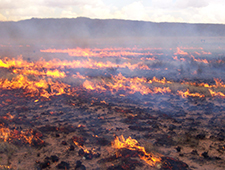
What information is needed to predict where fires will start in desert grasslands and how big they will get? Soil type turns out to play a larger role than expected.
As part of a study to understand the feasibility of reintroducing fire as a management tool in desert shrub- and grasslands, researchers examined 33 years of fire ignition data. They found that shallow and clayey soils, which support more continuous cover of perennial grasses, had higher fire frequencies than expected. Sandy and loamy soils supported fewer fires than expected. Other influences, such as mean annual precipitation, water holding capacity, and distance from roads are also important.
The study assessed the interactive effects of climate, urban development, and soil-landscape properties on fire distribution. The results can help refine landscape-level models of fire distribution, which land managers can use to develop long-term landscape management goals as well as short-term burn plans.










